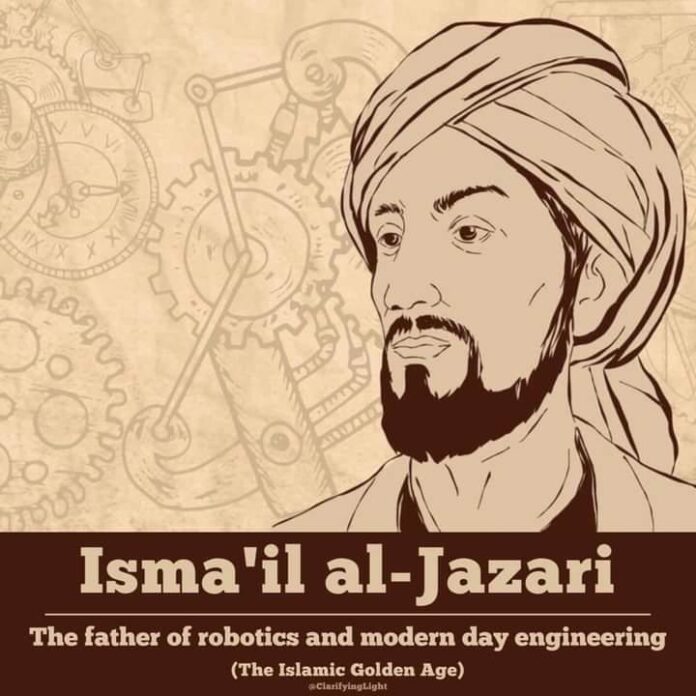This is al-Jazari, father of robotics and modern day engineering
By Ibrahim GIMBA, Abuja
Badīʿ az-Zaman Abu l-ʿIzz ibn Ismāʿīl ibn ar-Razāz al-Jazarī, IPA was a polymath, a scholar, inventor, mechanical engineer, artisan, artist and mathematician from the Artuqid Dynasty of Jazira in Mesopotamia.
Born: 1136, Upper Mesopotamia
Died: 1206
Books: The book of knowledge of ingenious mechanical devices
Book of knowledge in engineering tricks’)
In 1206, he described 50 mechanical devices, along with instructions on how to construct them. He is credited with the invention of the elephant clock. He has been described as the “father of robotics” and modern day engineering.
Al-Jazari was born in the area of Upper Mesopotamia in 1136. Sources state his exact location is unknown, but they speculate he could have been born in Jazirat ibn Umar, where he got the name Jazari from or Al-Jazira which was used to denote Upper Mesopotamia.
The only biographical information known about him is contained in his Book of Knowledge of Ingenious Mechanical Devices. Like his father before him, he served as chief engineer at the Artuklu Palace, the residence of the Mardin branch of the Artuqids which ruled across eastern Anatolia as vassals of the Zengid dynasty of Mosul and later of Ayyubid general Saladin. Although his ethnic origin is not certain, there are ideas that he is of Arab.
Al-Jazari was part of a tradition of artisans and was thus more a practical engineer than an inventor who appears to have been “more interested in the craftsmanship necessary to construct the devices than in the technology which lay behind them” and his machines were usually “assembled by trial and error rather than by theoretical calculation”.
His Book, Knowledge of Ingenious Mechanical Devices appears to have been quite popular as it appears in a large number of manuscript copies, and as he explains repeatedly, he only describes devices he has built himself. According to Mayr, the book’s style resembles that of a modern “do-it-yourself” book.
Some of his devices were inspired by earlier devices, such as one of his monumental water clocks, which was based on that of a Pseudo-Archimedes. He also cites the influence of the Banū Mūsā brothers for his fountains, al-Saghani for the design of a candle clock, and Hibatullah ibn al-Husayn (d. 1139) for musical automata.
Al-Jazari goes on to describe the improvements he made to the work of his predecessors, and describes a number of devices, techniques and components that are original innovations which do not appear in the works by his precessors.
The most significant aspect of al-Jazari’s machines are the mechanisms, components, ideas, methods, and design features which they employ.
Camshaft
A camshaft, a shaft to which cams are attached, was introduced in 1206 by al-Jazari, who employed them in his automata, water clocks (such as the candle clock) and water-raising machines. The cam and camshaft also appeared in European mechanisms from the 14th century.
Crankshaft and crank-slider mechanism
The eccentrically mounted handle of the rotary quern-stone in fifth century BCE Spain that spread across the Roman Empire constitutes a crank. The earliest evidence of a crank and connecting rod mechanism dates to the 3rd century AD Hierapolis sawmill in the Roman Empire.
The crank also appears in the mid-9th century in several of the hydraulic devices described by the Banū Mūsā brothers in their Book of Ingenious Devices.
In 1206, al-Jazari invented an early crankshaft, which he incorporated with a crank-connecting rod mechanism in his twin-cylinder pump. Like the modern crankshaft, al-Jazari’s mechanism consisted of a wheel setting several crankpins into motion, with the wheel’s motion being circular and the pins moving back-and-forth in a straight line.
The crankshaft described by al-Jazari transforms continuous rotary motion into a linear reciprocating motion, and is central to modern machinery such as the steam engine, internal combustion engine and automatic controls.
He used the crankshaft with a connecting rod in two of his water-raising machines: the crank-driven saqiya chain pump and the double-action reciprocating piston suction pump.[23][25] His water pump also employed the first known crank-slider mechanism.
Design and construction methods
English technology historian Donald Hill writes
We see for the first time in al-Jazari’s work several concepts important for both design and construction: the lamination of timber to minimize warping, the static balancing of wheels, the use of wooden templates (a kind of pattern), the use of paper models to establish designs, the calibration of orifices, the grinding of the seats and plugs of valves together with emery powder to obtain a watertight fit, and the casting of metals in closed mold boxes with sand.
Escapement mechanism in a rotating wheel
Al-Jazari invented a method for controlling the speed of rotation of a wheel using an escapement mechanism.
Mechanical controls
According to Donald Hill, al-Jazari described several early mechanical controls, including “a large metal door, a combination lock and a lock with four bolts”.
Segmental gear
A segmental gear is “a piece for receiving or communicating reciprocating motion from or to a cogwheel, consisting of a sector of a circular gear, or ring, having cogs on the periphery, or face.” Professor Lynn Townsend White, Jr. wrote:
Segmental gears first clearly appear in al-Jazari, in the West they emerge in Giovanni de Dondi’s astronomical clock finished in 1364, and only with the great Sienese engineer Francesco di Giorgio (1501) did they enter the general vocabulary of European machine design.
Follow the Neptune Prime channel on WhatsApp: https://whatsapp.com/channel/0029Va74ZvU2v1IqKByXoX3d
Do you have breaking news, interview request, opinion, suggestion, or want your event covered? Email us at neptuneprime2233@gmail.com


